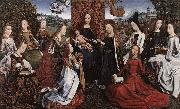All Master of the Saint Lucy Legend Oil PaintingsNetherlandish Northern Renaissance Painter, 15th Century |
|||
 |
|||
|
|
|
||||||||||
|
|
||||||||||
|
Legend of St Lucy Pintura identificación:: 51038 |
Legend of St Lucy 1480 Oil on oak panel, 79 x 183 cm |
|||||||||
|
|
||||||||||
|
|
Virgin Surrounded by Female Saints Pintura identificación:: 63965 |
Virgin Surrounded by Female Saints 1488 Oak, 108 x 171 cm Musees Royaux des Beaux-Arts, Brussels An anonymous painter working in the last two decades of the 15th century at Bruges, the Master of the Legend of St Lucy takes his name from a painting representing three episodes from the legend of this saint (Bruges, Sint-Jakobskerk). He paints willowy women with oval faces, and with slightly slit eyes under long, puffed eyelids, whose somewhat affected manner calls to mind the art of his contemporary Memling. According to archive sources, the Virgin Surrounded by Female Saints was placed in 1489 in the church of the Our Lady in Bruges on the altar belonging to the rhetoric chamber named De drie Sanctinnen (the three female saints), and was therefore likely painted shortly before that date. The three saints in question are Catherine, Mary Magdalen and Barbara, all widely venerated in Bruges. They surround a Virgin and Child, forming the central group of the composition. The Virgin is represented as the Queen of Heaven. She wears a crown and is seated on a throne behind which two angels hold aloft a rich brocade honour cloth. The scene takes place in an enclosed garden, full of plants and flowers, evoking Paradise. A landscape extends far into the background. The eleven young women surrounding the Virgin can be identified by their various attributes accompanying them or decorating their rich garments. The Child is holding a ring to Catherine in order to seal their "mystical marriage". This saint is also accompanied by a sword and her mantle is decorated with wheels. Mary Magdalene can be recognised by her ointment pot and Barbara by the towers that decorate her brocade mantle and her necklace. To the left, Ursula is identified by the arrows of her martyrdom half hidden beneath her gown, Apollina by a tooth in a pair of pincers and Lucy by a tray with two eyes on it. An unidentified saint holds a crown and a bell. To the right, Agnes carries a lamb in her lap and presents a ring, signifying her mystical marriage with Christ. Cunera, a companion of Ursula, carries a little cradle or footstool, along with an arrow, and Agatha a pair of pincers holding a torn-off breast. Margaret holds a cross in her hand. She is also accompanied in the landscape by a representation of St George slaying the dragon, a scene with which she is frequently associated. , Artist: MASTER of the Saint Lucy Legend , Virgin Surrounded by Female Saints , 1451-1500 , Flemish , painting , religious |
||||||||
|
|
||||||||||
|
|
St Sebastian Pintura identificación:: 64200 |
St Sebastian 1480-90 Oil on oak panel, 70 x 26,7 cm Gallery Robert Pintelon, Aalst St Sebastian is standing frontally with his hands over his head tied to a tree in a tree-filled landscape with abundant vegetation in the foreground. The towers of a castle loom up in the background. Apart from his loincloth he is naked. Both sides of his body are pierced with arrows. The handling of light is full of contrast, with ample use of white lead on the rosy skin standing out against the very dark green of the surroundings. Various characteristics in the manner of painting and the style, as well as the conception, enable us to ascribe this hitherto unknown panel to the Master of the Legend of St Lucy. The stiff, marionette-like figures with heavily drawn features; the hard, richly contrasted palette; and the systematic use in his landscapes of stereotypical vegetation and towers or city views in the distance are typical of nearly all his compositions. In this St Sebastian all these elements are clearly visible. The physiognomy with the heavy nose and the rather oriental eyes with large, vaulted upper eyelids and bushy eyebrows is to be seen in several of his works, for example, the Lamentation in Minneapolis and in the Tallinn altarpiece. The flat folds of the loincloth can be compared with the Virgin's head-scarf in the Lamentation of the Thyssen Foundation, where Christ's torso has been modelled in much the same way. The manner in which the vegetation is treated is almost identical in the St John on Patmos of Rotterdam and in the Legend of St Lucy in St James' Church in Bruges. Owing to its small format, it can be suspected that the St Sebastian was the wing of a triptych. The painting on the reverse was probably planed away when the cradle was applied. , Artist: MASTER of the Saint Lucy Legend , St Sebastian , 1451-1500 , Flemish , painting , religious |
||||||||
|
|
||||||||||
|
| ARTISTA PREVIO PROXIMO ARTISTA | |||||||||
|
|
||||||||||
| Master of the Saint Lucy Legend | ||||||||||
| Netherlandish Northern Renaissance Painter, 15th Century | ||||||||||
|
|
||||||||||
|
CONTACTE EEUU |








